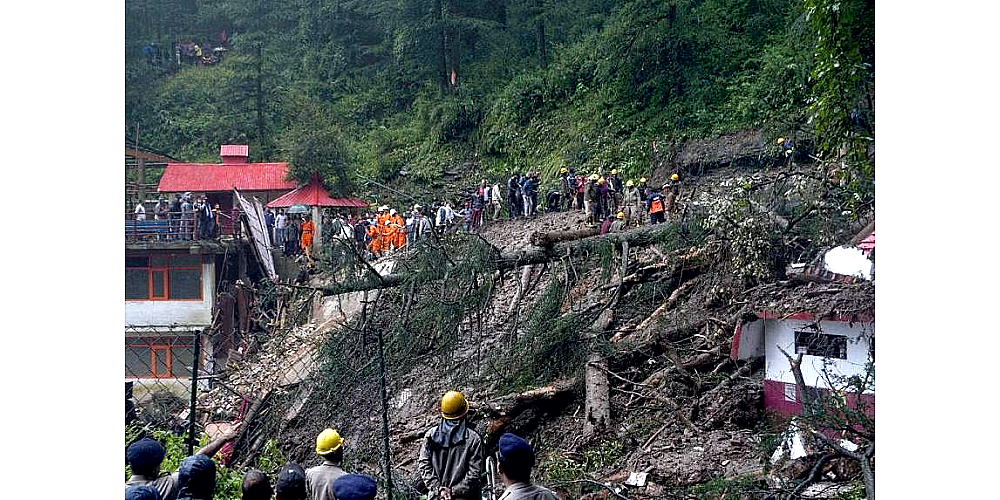It was a grueling summer in Ballia, a district in the northern Indian state of Uttar Pradesh.
Temperatures in mid-June hovered around 45 deg C, causing more than 60 suspected heatstroke-related deaths in just a matter of days.
But Mr Shivdas Rajwar, a 48-year-old small-scale farmer in the district’s Baro Panno village, toiled in the fields throughout this scorching period, preparing the ground for padi sowing ahead of the peak monsoon season in July and August.
He had little choice. “If I don’t work, how will we survive?” he said.
His annual earnings of about 200,000 rupees (RM11,283) from little more than three hectares of farmland, nearly all of it leased, supports his wife and three children.
But more than a month into the monsoon season that began in June, Mr. Rajwar was still a worried man.
The rains – critical for a good rice yield – remained elusive over much of the padi-growing region in the Indo-Gangetic plains, including in Baro Panno, where Mr. Rajwar said it had rained on just three days.
“If it doesn’t rain soon enough, I am scared it will cut down my harvest,” added the farmer, who fears his earnings in 2023 could fall lower than 100,000 rupees.
Mr. Rajwar’s plight mirrors wider concerns among an estimated 150 million farmers in India, most of whom rely extensively on monsoon rainfall to irrigate their fields.
Once a faithful friend of farmers in the subcontinent, with evenly spread and generous showers, the monsoon has turned fickle, with long dry periods and sudden outbursts, affecting agricultural productivity and livelihoods.

India’s vulnerability
The monsoon’s unpredictability is just one of the many risks India, the world’s most populous nation, is exposed to because of climate change.
India ranks among the top five countries most vulnerable to climate risks.
Its people are already grappling with an increasing rate of extreme weather events that have caused large-scale displacement of humans, loss of infrastructure, deaths and reduced labor productivity because of heat stress.
A 2020 study by the Council on Energy, Environment and Water, a New Delhi-based think-tank, underlined this vulnerability.
While India witnessed 250 extreme weather events in the 3½ decades since 1970, the 14-year period that followed, up to 2019, saw as many as 310 extreme and associated events, including heat and cold waves.
The year 2023 further reinforced this risk. February was the hottest since record-keeping began in 1901 and heatwaves came as early as March, instead of the usual May or June when summer temperatures peak.
This was followed by Biparjoy in June, the longest-duration cyclone in the northern Indian Ocean in more than 45 years and which lasted for 13 days and three hours.
Next came unprecedented rainfall in north India, triggering landslides and flooding, especially in the northern state of Himachal Pradesh, where more than 200 have died since July.
This vulnerability to extreme weather events arises because of India’s geographical location.
Its peninsular region is surrounded by tropical waters, which are warming faster than any other tropical ocean region, leading to greater frequency of cyclones; and its north is hemmed in by the Himalayas, where glaciers are melting at unprecedented rates and provoking flash floods.
“On all its four sides, India is grappling with a rapidly changing climate,” said Dr. Roxy Mathew Koll, a climate scientist at the Indian Institute of Tropical Meteorology in Pune city.
Research by him and his team has shown how cyclones are intensifying rapidly due to warming oceans in India’s vicinity.
Warmer sea-surface temperatures have also decreased the mean summer monsoon rainfall over India while aggravating extreme rainfall events, such as the one seen over the northern Himalayan states in 2023.
“This is because monsoon circulation has weakened slightly in response to Indian Ocean warming, but at the same time there are episodes of strong winds that carry all that moisture from the oceans and dump it all of a sudden,” Dr Koll told The Straits Times.
Projections of how India could be affected over time are dire.
Rain-fed rice yields may fall by 20 per cent in 2050 and extreme heat could cut outdoor working capacity during daylight hours by 15 per cent by 2050.
As much as 4.5 per cent of India’s gross domestic product (GDP) could be at risk by 2030 owing to lost labor hours from extreme heat and humidity, noted the Reserve Bank of India in a 2023 report.
Concerns about a diminished rice yield because of an erratic monsoon in 2023 led India to ban the export of widely consumed non-basmati white rice varieties in July, accentuating climate change’s impact on not just the country’s food security but also that of other countries, given India’s role as the world’s largest exporter of rice.
All this has left India with little choice but to act against climate change that the country’s Prime Minister Narendra Modi has described as one of the three greatest threats to civilization.
Decarbonization strategy
India’s commitment to fight global warming is enshrined in its enhanced nationally determined contributions (NDCs) that were approved in 2022.
These include a pledge to reduce greenhouse gas (GHG) emissions intensity of GDP by 45 per cent by 2030 from 2005 levels, up from 33 to 35 per cent in its first NDCs in 2015.
NDCs are key elements of a global climate action plan to cut emissions and adapt to climate impacts that was adopted by 196 parties in 2015 at COP21, the Paris edition of the annual United Nations Climate Change Conference.
Under its updated NDCs, India will also have about 50 per cent of its total installed electric power capacity based on non-fossil-fuel energy sources – primarily solar, wind and hydro power – by 2030, a jump from 40 per cent in its earlier pledge.
An overarching goal of net-zero emissions – cutting of greenhouse gas emissions to as close to zero as possible – by 2070 was also included, along with its target of a carbon sink of 2.5 billion to three billion tons of carbon-dioxide (CO2) equivalent through additional forest and tree cover by 2030.
The country has been making rapid strides towards these goals, one that is built on an aggressive roll-out of renewables, along with a push for green hydrogen and electric mobility.
Since 2018, India’s renewable energy capacity (including large hydro power) has grown nearly 60 per cent and capacity addition in renewables exceeded that of coal and gas by more than 75 per cent in the period from 2017 to 2022.
India today ranks fourth among countries with the highest solar and wind electricity capacity, after China, the United States and Germany.
As at June, India had a total renewable energy capacity of nearly 176.5GW, with renewables accounting for 42 per cent of the total capacity mix and 24.6 per cent of that month’s energy generation.
The country remains committed to its goal of installing a 500GW renewable energy capacity by 2030, making up around 64 per cent of the anticipated capacity mix.
“India’s goals are ambitious and its vision of where it wants to go is very clear,” said Mr. Chandra Bhushan, founder-CEO of the International Forum for Environment, Sustainability and Technology, a New Delhi-based think-tank.
“India will be the first major developing country in the world that will decarbonize before it becomes developed.”
Hurdles remain though. India fell short of its renewable energy capacity target of 175GW by 2022 – putting in place 120.9GW instead – mainly due to a slow roll-out of rooftop solar and wind energy projects.
India’s dependence on coal also remains strong, with thermal energy accounting for more than 70 per cent of its monthly energy generation as at June 2023.

Slow mover?
India has taken the lead on global initiatives such as the International Solar Alliance, which seeks to hasten the deployment of solar energy worldwide, and the Coalition for Disaster Resilient Infrastructure that aims to build resilience into infrastructure systems.
Yet, India – the world’s third-biggest emitter of carbon emissions, although its per capita emissions are less than half of the world average – has been criticized at international climate talks for defending the use of planet-warming fossil fuels to further its growth as well as being a slow mover on ultimately decarbonizing its economy. Its 2070 net-zero target, for instance, is a decade later than the targets of Nigeria and Indonesia.
At the 2021 COP26, India had supported “phasing down” coal, and its National Electricity Plan for 2022-2032 envisages a growth in coal-fired power capacity till 2031-2032, albeit by a smaller margin compared with renewables.
Such a phasing down instead of phasing out of coal was criticized.
Indian experts, however, argue that this criticism overlooks the wider picture – its significantly larger expansion of renewables in the long run.
Of the 291,802MW capacity addition envisaged during 2027-2032, coal will account for just 25,480MW compared with 259,722MW from renewables.
“Energy transition goals are not for the next five years. You make plans for the next 30 years,” Mr. Bhushan told ST, adding that India was “on the right track” to decarbonize itself.
Besides, coal remains an affordable source of energy, especially for India that has large unmet development needs.
Its per capita emissions are still less than a third of the Group of 20 average.
Even a refrigerator in the United States gobbles nearly half the energy that is consumed by an average Indian in a year.
“Can a government deny its people access to electricity by saying it is working on renewable energy? No country will do that,” said Mr. Bhushan.
Even activists who criticize certain aspects of India’s climate actions note that its NDCs are just, considering its far smaller role in warming the planet – given its lower share in historical global emissions – unlike the outsized role of rich and developed countries that account for much of the GHGs emitted since the 1850s.
A 2021 analysis by The New York Times found that 23 rich countries, including the US, Canada, Japan and much of western Europe, were responsible for half of all the planet-warming greenhouse gases released from fossil fuels and industry over the past 170 years.
The other half came from more than 150 countries, including India.
There is also a lack of financial and technical support from developed countries to help developing ones transition to greener growth models.
Much of India’s green financing, which is already falling short of its needs, comes from domestic resources.
They totaled US$44 billion for the financial years of 2019 and 2020, about a fourth of what the country needs.
International sources accounted for just 17 per cent of this funding in FY2020, according to a 2022 study by the Climate Policy Initiative.
Mr. Harjeet Singh, head of global political strategy at Climate Action Network, which brings together climate action groups in 130 countries, said if the world has to become carbon-neutral by 2050 – as climate scientists have urged to prevent the worst climate disasters – rich and developed countries such as the US have to attain net-zero emissions much earlier than their current target of 2050.
“It should become carbon-neutral by 2030, ideally many years before that because of its historical responsibility, because of the kind of resources it has. If they don’t do it, how can they push other countries such as India to become carbon-neutral?” he said.
India’s net-zero target by 2070, two decades later than the US and a decade later than China, is a reflection of this inaction by other parties, he said.
“A lot of what happens at international climate talks is not entirely based on science. It is also based on geopolitics; it is based on what others are doing.”
Adapting to reality
But India, given its high exposure to climate risks, cannot afford to wait for others to act, especially when the world’s emissions continue to go up.
The costs of damage in India due to climate inaction may total US$35 trillion (S$47.7 trillion) by 2070, according to a Deloitte Economics Institute report in 2021.
It is here that adaptation becomes critical, as it will save lives and livelihoods in the short to medium term and build long-term resilience to impacts of climate change.
While India has done well to build early warning systems and evacuate people from harm’s way when cyclones strike, efforts in other sectors, such as building climate-resilient agriculture or designing urban infrastructure to absorb climate shocks, have lagged behind.
Dr Chandni Singh, a lead author for the UN’s Intergovernmental Panel on Climate Change and a senior researcher at the Indian Institute for Human Settlements, Bengaluru, said India has also overlooked how its underlying socioeconomic vulnerabilities can worsen a person’s experience of climate shocks. These include poor access to healthcare, electricity, education and other basic services.
This is especially true of poor and unskilled economic migrants in Indian cities who take up jobs in the informal economy without any social security benefits.
They lack the safety net of their family or relatives back home as well as government support such as free and subsidized rations that are linked to identity documents mostly registered to their home addresses.
“Good adaptation is built on the bedrock of good development,” Dr Singh told ST, calling for measures that empower people to decide for themselves.
“If some people want to stay back in their villages, livelihoods should be made resilient there and enough economic opportunities provided. And if some people do want to move to cities, they should be enabled to move in a way that’s safe, that’s resilient.”
Ensuring a just transition – especially for the estimated five million whose jobs depend on the coal sector – is another challenge, as is the need to create a model of development that relies on judicious and equitable access to energy.
But, Climate Action Network’s Mr. Singh noted, “India has been blindly following the same growth model from the West, which caused the problem in the first place.”

ADVERTISEMENT
ADVERTISEMENT








































